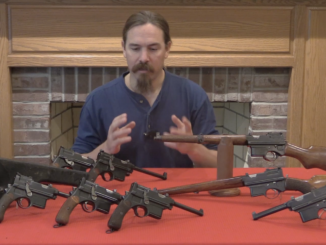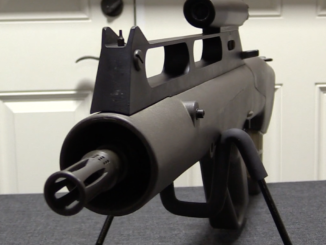Today we are looking at a pair of Steyr 1893 trials revolvers. Only about 100 of these were made, primarily for Austro-Hungarian military trials. These two are early pattern examples, with Pieper-type gas seal systems in which the cylinder is cammed forward upon firing and an extra-long cartridge case bridges the gas between cylinder and barrel. This slightly increases muzzle velocity by eliminating the gas leak at the cylinder gap, but it does so at the cost of extra complexity and a very poor trigger pull.
In addition to that system, the Steyr 1893 features a tip-out cylinder and central ejector, which would make reloading quite rapid for the time. It held 7 rounds of 8mm ammunition (a gas-seal 8mm cartridge). A later version of the gun replaced this with a fixed cylinder and an Abadie loading gate system. Neither of these would be adopted, and the Rast & Gasser model 1898 would be chosen instead.
Interestingly, one of these two revolvers has a Nazi-era German civilian proof on the cylinder, suggesting that it was sold on the commercial market in Germany during that time, and thus required proofing. The majority of these revolvers have no proofs, as they were never sold commercially by Steyr.




I assume this was disruptive innovation as the implementation of future successful concepts didn’t work out. I could be wrong.
Well, generally speaking bottom line is negative: using more complicated design gap was eliminated but gains are marginal: minimal boost in muzzle velocity.
However I think such solution – with “hidden” bullet – could be used to mate tubular-magazine (as found in lever-action rifles) with Spitzer bullet. With hidden bullet there is no risk of activating primer of next cartridge.
“However I think such solution – with ‘hidden’ bullet – could be used to mate tubular-magazine (as found in lever-action rifles) with Spitzer bullet. With hidden bullet there is no risk of activating primer of next cartridge.”
In general, I am sceptical about the solutions, which need special cartridge.
“In general, I am sceptical about the solutions, which need special cartridge.”
Special ammunition is always cost, however notice that such type of cartridge might be created either by elongating case or seating bullet more deeper, though second method required long enough neck – like in .22 Hornet or .30 Winchester.
Concerning the velocity savings from the use of the gas seal feature. I am speaking now about the Russian Nagant that uses the same gas seal system. I cronographed a number of rounds from the Russian Nagant using Russian Surplus ammo and recorded 857 fps average MV. I was somewhat disappointed. I was expecting performance on the level of the .32-20 WCF, but it turned out to be just a hot loaded .32 S&W Long. Oh well, I suppose one .32 cal. hole is much like another since that’s all non-expanding bullets do anyway.
The only advantage that the Nagant has over other revolvers in this regard is that it can have a suppressor stuck on the muzzle. Having no cylinder gap means that no gas and flash leak out through the frame.
“only”
Not, such construction allow crafting of revolver-carbine, see image in link:
https://warbook.info/item/nagan-karabin-pogranichnyj-inzhenernyj-karabin
without problems of flash from gap.
“- The only advantage that the Nagant has over other revolvers in this regard is that it can have a suppressor stuck on the muzzle. Having no cylinder gap means that no gas and flash leak out through the frame.
– Not, such construction allow crafting of revolver-carbine […] without problems of flash from gap.”
By the way, the gas seal system also improves the accuracy of revolver (see TOZ 36, TOZ 49, and Nagant M1895 conversion target revolvers):
1. it can perfectly indexes the chambers of the cylinder and the bore of the barrel;
2. the projectile directly enters to the forcing cone, without or with minimized unguided flying through the unrifled chamber and cylinder-barrel gap.
I think, the gas seal system provides easier cleaning, because the powder residue contained only in the chamber and the barrel.
As far as I know, the Nagant brothers had problem with flame cutting of the frame above the cylinder-barrel gap, dure to the inferior quality of steel and the smokeless powder. The gas seal system solved this problem.
In case of muzzleloader revolvers, the gas seal system also reduces the chance of chainfire: as far as I know, this is, why the gas seal system originally invented (for example: Puckle gun, Collier, Joseph Lang, Philip Webley revolvers).
The link to the Nagant carbine is fascinating. Thank you.
“velocity savings from the use of the gas seal feature”
Actually it is negligible, give few % increase at most.
“857 fps average MV”
Correct. According to my data historically used 7,62x38R Nagant should give muzzle velocity 270…290 m/s (823,5…884,5 in Imperial)
As I see, the Steyr 1893 revolver very similar (but not perfectly idenctical) to the Pieper 1893 revolver [http://gunlab.net/pieper-m-1893-revolver/]. Is there any known connection?
By the way, is it know…
– …the proper caliber of the Steyr 1893? 8mm Pieper?
– …why have the cylinder flutes so unusual, pear-shaped shape?
As far as I known, Henri Pieper patented the concept of gas seal revolver with metallic (wadcutter, “hidden” bullet, elongated case etc.) cartridge in 1899, which originated from Henri Joseph Vervier. Unfortunately, I have not found any patent or source.
Construction must be belonged to Pieper… Cylinder fluting should be multi purposed; Lightening the mass and indexing it before forwading to the barrel. If noticed, there is a lever in front of the trigger which accomplishes this. The rear end of it should also serves to retract the clinder after firing if enlarged case mouth stickes into the barrel enterance which needing a powerfull leverage to take it away which causing the heavy trigger pull.
Double action sear seems fixed integral with hammer and trigger seems having a movable double action lifter tip working together with cylinder rotation hand.
Very well designed, cleverly constructed masterpiece of engineering.
Those are really interesting
Before I get to the design, Ian referred to the Straw colour finish of many of the parts.
There are a range of colours produced by the increasing thickness of the oxide film that develops on a polished steel surface as it is heated.
The colours are partly the base colour of the magnetic iron oxide, and partly due to interference patterns due to the film thickness and the crystal size of the oxides.
In plain carbon steels, the colurs can be used to estimate the temperature for tempering. “Straw” is actually pretty hard, it’s not bad for knife and wood working chisel blades.
I’ll disagree with Ian, there is a tiny bit of protection from any oxide coating, but a straw colour coating is very thin compared to the much thicker “blue” temper coating associated with the higher temperature spring temper.
The rebounding hammer and the (almost a) transfer bar safety… point the way forward in revolver trigger mechanisms.
The cylinder release on the crane looks like an interesting thing to play with. Is it as fast or faster than a release above the grip?
I wonder how the chamber size works out? 8mm Rast-Gasser is within reasonable tolerances the same as .32 H&R mag.
But, yeah, the guns are probably too good to shoot.
You guys all miss the point. Cylinder gap is sloppy. It’s an engineering shortcoming. .30 caliber 100 grain at 110ofps is deadly and seven shots is formidable. You get a gas seal plus easy suppression with a fixed barrel and no ejection for extra clandestine operations. ..Recordings of use with supression is not well documented but is a modern dream in a revolver were it possible..Oh yeah, it is in the Nagant a nd piper (Another gas seal .30 7 shot same ammo). ..The Nagant has 70 plus years in service of both Russia and the USSR. That’s nothing to sneaze at. You pussies all bitch about the hard double action pull, but you only need double action in emergencies and quick shots YOU CAN DO with this gun. This gun, to this day, is a definite consideration for proper concealed carry to this day and I’ll call anybody on this. This gun saved a lot of lives and it took a lot of them to. This gun is perhaps the best pistol ever invented and created if you do it by the numbers and I’ll challenge anyone to that. The one disadvantage IT DOES HAVE is the ejection. On this situation the 1893 Steyr/Piper solved that problem, and if Excalibur were a pistol, it would be a Steyr 1893…